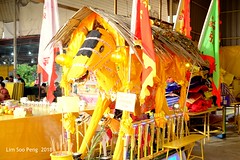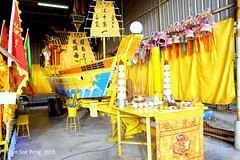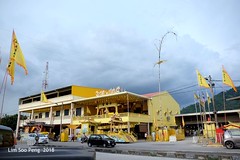The Leaves of the Lotus
Archive for the ‘Plants’ Tag
The Leaves of the Lotus 4 comments
Photo 101 ~ Day Eleven: A Pop of Colour – The Orange Berries 5 comments
Photo 101 ~ Day Eleven: A Pop of Colour – The Orange Berries
Though green is one of the primary colours, I could not get a hold of a photograph with a neutral coloured background. I took this photograph of the orange-coloured berries with its green leaves as background. The normal question invoked by looking at the strange coloured berries – are these poisonous? Do these berries cause itchiness? Can these berries be used as natural remedy for diseases?
SP Lim
THE ORANGE BERRIES
*************************************************************************************************************************************************
Photo 101, Day Eleven: Pop & Color
Josh R., Blogging U.
Day Eleven: A Pop of Color
The colors in our photographs are evocative and rouse emotions within us. Color can elevate a mundane image into something intriguing and meaningful, and can tell a particular story within the frame.
Consider this shot of a blue door in Malta:
The cobalt blue door and powder blue frame not only add a bright splash to an otherwise nondescript image, but also add layers of story and perspective: Who lives in this building? What’s behind that door?
The color blue is whimsical yet strong. To some, blue looks and feels soothing and serene, but also cold and apathetic.
While other shades are eye-catching in their own ways, here, the blue works well. A red door might change the mood of the picture, signaling excitement or danger.
Today, pay attention to how color affects your images. Experiment with one color, and think about how to feature it prominently.
Today’s Tip: As you train your eye to look for color, keep it simple:
Choose one bold color against a neutral background, instead of several colors competing for attention in a scene.
Look for a strong color within a basic composition of uncomplicated lines — your pop of color will stand out more.
Continue to experiment with light and POV as you shoot color-as-subject — the color may transform as you move.
Don’t ignore soft, pastel shades — colors like mint and pink can make statements, too.
Juxtapose pastels with black and darker shades.
When in doubt, pair an accent color with white — you’ll see its impact immediately.
Cheers,
Josh R. and the WordPress.com Team
#################################################################################################################################################
Coconut Trees, Palm Trees and others Leave a comment
Coconut Trees, Palm Trees and others
It was such a hot and sunny day with blue sky. The coconut trees, palm trees and other species of trees are enjoying the sunlight for their photosynthesis and generating oxygen for us in return of absorbing the carbon dioxide. What a great recyclable action by these plants towards humankind.
So I took these photographs to appreciate the excellent work done by these green plants to us. Thank you.
SP Lim

From Wikipedia
In botany, a tree is a perennial plant with an elongated stem, or trunk, supporting branches and leaves in most species. In some usages, the definition of a tree may be narrower, including only woody plants with secondary growth, plants that are usable as lumber or plants above a specified height. Trees are not a taxonomic group but include a variety of plant species that have independently evolved a woody trunk and branches as a way to tower above other plants to compete for sunlight. In looser senses, the taller palms, the tree ferns, bananas and bamboos are also trees. Trees tend to be long-lived, some reaching several thousand years old. The tallest known tree, a coast redwood named Hyperion, stands 115.6 m (379 ft) high. Trees have been in existence for 370 million years. It is estimated that there are just over 3 trillion mature trees in the world.
A tree typically has many secondary branches supported clear of the ground by the trunk. This trunk typically contains woody tissue for strength, and vascular tissue to carry materials from one part of the tree to another. For most trees it is surrounded by a layer of bark which serves as a protective barrier. Below the ground, the roots branch and spread out widely; they serve to anchor the tree and extract moisture and nutrients from the soil. Above ground, the branches divide into smaller branches and shoots. The shoots typically bear leaves, which capture light energy and convert it into sugars by photosynthesis, providing the food for the tree’s growth and development. Flowers and fruit may also be present, but some trees, such as conifers, instead have pollen cones and seed cones; others, such as tree ferns, produce spores instead.

Trees play a significant role in reducing erosion and moderating the climate. They remove carbon dioxide from the atmosphere and store large quantities of carbon in their tissues. Trees and forests provide a habitat for many species of animals and plants. Tropical rainforests are one of the most biodiverse habitats in the world. Trees provide shade and shelter, timber for construction, fuel for cooking and heating, and fruit for food as well as having many other uses. In parts of the world, forests are shrinking as trees are cleared to increase the amount of land available for agriculture. Because of their longevity and usefulness, trees have always been revered and they play a role in many of the world’s mythologies.
A Trip to the Monkey Cup Garden at Penang Hill 1 comment
A Trip to the Monkey Cup Garden at Penang Hill
From Wikipedia:-
A vine (Latin vīnea “grapevine”, “vineyard”, from vīnum “wine”) in the narrowest sense is the grapevine (Vitis), but more generally it can refer to any plant with a growth habit of trailing or scandent (that is, climbing) stems or runners. The word also can refer to such stems or runners themselves, for instance when used in wicker work.
In the United Kingdom, the term “vine” applies almost exclusively to the grapevine. The term “climber” is used for all climbing plants.
Nepenthes, a genus of carnivorous plants known as tropical pitcher plants or monkey cups Pandorea pandorana, the wonga wonga vine Parthenocissus quinquefolia

Nepenthes rajah /nɨˈpɛnθiːz ˈrɑːdʒə/ is an insectivorous pitcher plant species of the Nepenthaceae family. It is endemic to Mount Kinabalu and neighbouring Mount Tambuyukon in Sabah, Malaysian Borneo. Nepenthes rajah grows exclusively on serpentine substrates, particularly in areas of seeping ground water where the soil is loose and permanently moist. The species has an altitudinal range of 1500 to 2650 m a.s.l. and is thus considered a highland or sub-alpine plant. Due to its localised distribution, N. rajah is classified as an endangered species by the IUCN and listed on CITES Appendix I.
The species was collected by Hugh Low on Mount Kinabalu in 1858, and described the following year by Joseph Dalton Hooker, who named it after James Brooke, the first White Rajah of Sarawak. Hooker called it “one of the most striking vegetable productions hither-to discovered”. Since being introduced into cultivation in 1881, Nepenthes rajah has always been a much sought-after species. For a long time, the plant was seldom seen in private collections due to its rarity, price, and specialised growing requirements. However, recent advances in tissue culture technology have resulted in prices falling dramatically, and N. rajah is now relatively widespread in cultivation.
Nepenthes rajah is most famous for the giant urn-shaped traps it produces, which can grow up to 41 cm high and 20 cm wide. These are capable of holding 3.5 litres of water and in excess of 2.5 litres of digestive fluid, making them probably the largest in the genus by volume. Another morphological feature of N. rajah is the peltate leaf attachment of the lamina and tendril, which is present in only a few other species.
The plant is known to occasionally trap vertebrates and even small mammals, with drowned rats having been observed in the pitcher-shaped traps. It is one of only two Nepenthes species documented as having caught mammalian prey in the wild, the other being N. rafflesiana. N. rajah is also known to occasionally trap small vertebrates such as frogs, lizards and even birds, although these cases probably involve sick animals and certainly do not represent the norm. Insects, and particularly ants, comprise the staple prey in both aerial and terrestrial pitchers.

Although Nepenthes rajah is most famous for trapping and digesting animals, its pitchers are also host to a large number of other organisms, which are thought to form a mutually beneficial (symbiotic) association with the plant. Many of these animals are so specialised that they cannot survive anywhere else, and are referred to as nepenthebionts. N. rajah has two such mosquito taxa named after it: Culex rajah and Toxorhynchites rajah.
Another key feature of N. rajah is the relative ease with which it is able to hybridise in the wild. Hybrids between it and all other Nepenthes species on Mount Kinabalu have been recorded. However, due to the slow-growing nature of N. rajah, few hybrids involving the species have been artificially produced yet.
Carnivorous plants are plants that derive some or most of their nutrients (but not energy) from trapping and consuming animals or protozoans, typically insects and other arthropods. Carnivorous plants have adapted to grow in places with high light where the soil is thin or poor in nutrients, especially nitrogen, such as acidic bogs and rock outcroppings. Charles Darwin wrote Insectivorous Plants, the first well-known treatise on carnivorous plants, in 1875.
True carnivory is thought to have evolved independently nine times in five different orders of flowering plants, and is represented by more than a dozen genera. This classification includes at least 583 species that attract, trap and kill prey, absorbing the resulting available nutrients. Additionally, over 300 protocarnivorous plant species in several genera show some but not all of these characteristics.
Malaysian Orchids Leave a comment
Malaysian Orchids I used to plant orchids and ornamental plants as a hobby during my varsity days. Somehow, my interest died as I have no “green fingers” and the plants withered off after some years. I thought to myself – taking photographs will actually preserve these beautiful blooms forever. So, no more using a hammer to break bricks, roof tiles and charcoal – the media for the orchid plants and seedling to grow upon. So, enjoy this series of colourful and beautiful Malaysian Orchids which I photographed at the Floral Fest 2014 early in the year.
SP Lim
From Wikipedia
Orchidaceae is a diverse and widespread family of flowering plants with blooms that are often colourful and often fragrant, commonly known as the orchid family. Along with the Asteraceae, they are one of the two largest families of flowering plants, with between 21,950 and 26,049 currently accepted species, found in 880 genera. The determination of which family is larger is still under debate, because verified data on the members of such enormous families are continually in flux. Regardless, the number of orchid species nearly equals the number of bony fishes and more than twice the number of bird species, and about four times the number of mammal species. The family also encompasses about 6–11% of all seed plants. The largest genera are Bulbophyllum (2,000 species), Epidendrum (1,500 species), Dendrobium (1,400 species) and Pleurothallis (1,000 species).
The family also includes Vanilla (the genus of the vanilla plant), Orchis (type genus), and many commonly cultivated plants such as Phalaenopsis and Cattleya. Moreover, since the introduction of tropical species into cultivation in the 19th century, horticulturists have produced more than 100,000 hybrids and cultivars.
Inserted by SP Lim
A Nature Walk in the Penang Botanic Garden Leave a comment
A Nature Walk in the Penang Botanic Garden ~ the photo series which I took when I was shooting with Ban Seng. Tress and plants are still interesting subjects to shoot. If an insect drops by, it shall be additional attraction.
SP Lim
Of orange berries and plants Leave a comment
With the abundance of nature surrounding the tropical environment, we can see many plants, shrubs and trees. Apart from admiring these natural beauties, we must bear in mind these plants generate the much needed oxygen to our atmosphere.
SP Lim
Sometimes when I think how good my book can be, I can hardly breathe. — Truman Capote
Penang Floral Fest started last Sunday at the Penang Botanic Garden 2 comments
The Penang Floral Fest 2012Date: 3rd to 10th June 2012
Contact: 604-2270428
Location: Penang Botanic Gardens
THE Penang Floral Festival 2010 is expected to draw some 50,000 local and foreign visitors to Penang Botanic Gardens.
Workshops, contests, exhibitions and various classes on floral related topics will be held during this floral festival.
Remember to bring along your camera to snap photos of trees and plants that are bountiful in the gardens.
Extracted from George Town, Penang Facebook commentary.
SP Lim
I loved words. I love to sing them and speak them and even now, I must admit, I have fallen into the joy of writing them. — Anne Rice
Just Orchids – Phalaenopsis Leave a comment
Yesterday I cannot add photo album for unknown reason but today it is back to normal. These photographs were taken at the year end Floral Fest held at Penang Botanic Garden on around 12 December 2010.
From my Photo Archives of Flowers Leave a comment
Browsing through my photo archives as my CPU has just crashed some 2 weeks ago as the motherboard had burnt out, I notice this file on flowers and plants. Have I uploaded these before but any way I hope you can enjoy looking at these flowers as these might vanish one of these days.
SP Lim






































































































































































































































































































